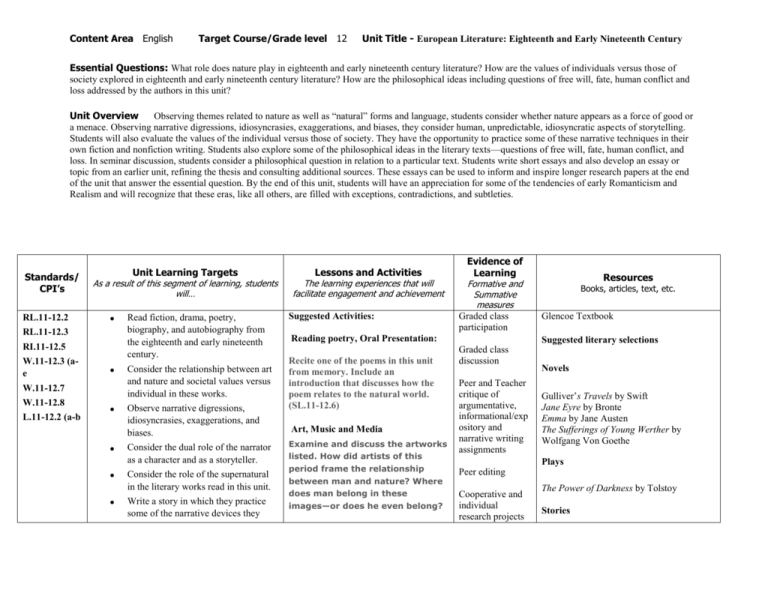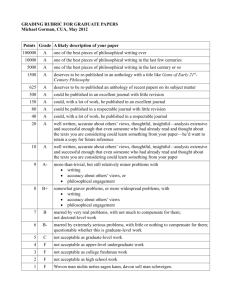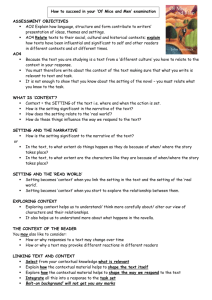English-English IV-Unit 4-Eur Lit
advertisement

Content Area English Target Course/Grade level 12 Unit Title - European Literature: Eighteenth and Early Nineteenth Century Essential Questions: What role does nature play in eighteenth and early nineteenth century literature? How are the values of individuals versus those of society explored in eighteenth and early nineteenth century literature? How are the philosophical ideas including questions of free will, fate, human conflict and loss addressed by the authors in this unit? Unit Overview Observing themes related to nature as well as “natural” forms and language, students consider whether nature appears as a force of good or a menace. Observing narrative digressions, idiosyncrasies, exaggerations, and biases, they consider human, unpredictable, idiosyncratic aspects of storytelling. Students will also evaluate the values of the individual versus those of society. They have the opportunity to practice some of these narrative techniques in their own fiction and nonfiction writing. Students also explore some of the philosophical ideas in the literary texts—questions of free will, fate, human conflict, and loss. In seminar discussion, students consider a philosophical question in relation to a particular text. Students write short essays and also develop an essay or topic from an earlier unit, refining the thesis and consulting additional sources. These essays can be used to inform and inspire longer research papers at the end of the unit that answer the essential question. By the end of this unit, students will have an appreciation for some of the tendencies of early Romanticism and Realism and will recognize that these eras, like all others, are filled with exceptions, contradictions, and subtleties. Standards/ CPI’s RL.11-12.2 Unit Learning Targets As a result of this segment of learning, students will… RL.11-12.3 RI.11-12.5 W.11-12.3 (ae W.11-12.7 W.11-12.8 L.11-12.2 (a-b Read fiction, drama, poetry, biography, and autobiography from the eighteenth and early nineteenth century. Consider the relationship between art and nature and societal values versus individual in these works. Observe narrative digressions, idiosyncrasies, exaggerations, and biases. Consider the dual role of the narrator as a character and as a storyteller. Consider the role of the supernatural in the literary works read in this unit. Write a story in which they practice some of the narrative devices they Lessons and Activities The learning experiences that will facilitate engagement and achievement Suggested Activities: Evidence of Learning Formative and Summative measures Graded class participation Reading poetry, Oral Presentation: Recite one of the poems in this unit from memory. Include an introduction that discusses how the poem relates to the natural world. (SL.11-12.6) Art, Music and Media Examine and discuss the artworks listed. How did artists of this period frame the relationship between man and nature? Where does man belong in these images—or does he even belong? Resources Books, articles, text, etc. Glencoe Textbook Suggested literary selections Graded class discussion Peer and Teacher critique of argumentative, informational/exp ository and narrative writing assignments Novels Gulliver’s Travels by Swift Jane Eyre by Bronte Emma by Jane Austen The Sufferings of Young Werther by Wolfgang Von Goethe Plays Peer editing Cooperative and individual research projects The Power of Darkness by Tolstoy Stories have observed in this unit. What do you see in these images? Explore and analyze some of the philosophical ideas in the literary texts—questions of free will, fate, human conflict, and loss. Which painting do you believe would be more “typical” of the period? Which looks more romantic in style to you, and Consider the difference between natural and forced language. Consider both the common tendencies of works of this period and the contradictions, exceptions, and outliers. Participate in a seminar discussion in which a philosophical question is explored in relation to a specific text. why? Do you believe these images were painted for “art’s sake,” or for a larger social purpose? (SL.11-12.1, SL.11-12.2, SL.11- and oral presentations Benchmarks Tests Poems Announced and unannounced quizzes 12.3, SL.11-12.4, SL.11-12.5) Three formal analyses Reading Literature, Argumentative Writing Based on Tolstoy’s The Bet, can a reader claim whether Tolstoy agrees or disagrees with the morality of the death penalty? Use evidence from the text to support all claims and counterclaims. (W.11-12.2) Reading Literature, Informative Writing Compare and contrast the themes found in The Diary of Samuel Pepys and The Life of Samuel Johnson. Do the texts share similar messages? Do they reflect elements of realism in the same way? Why or why not? Use evidence from both texts and organize in a comparative essay. Include an original, concise thesis statement. (RL.11-12.1, RL.11-12.3, RL.11-12.6, W.11-12.2, SL.11-12.1, SL.11-12.6) “How Much Land does a Man Need?” by Tolstoy “The Bet” by Chekhov “War” by Pirandello Two narrative writing assignments Two informational/exp ository writing assignments Four perspectives in response to art and literature “The Lorelei” by Heine “Russia 1812” from The Expiation by Hugo “The Panther” by Rilke Auguries of Innocence” “Songs of Innocence and of Experience” (selected poems) (William Blake) “Ode to Indolence” “Ode on a Grecian Urn” (excerpts) (John Keats) In Memoriam A. H. H. (Alfred Lord Tennyson) The Deserted Village” (Oliver Goldsmith) “Tintern Abbey” “London, 1802” “The World is too Much with Us” “Ode to Intimations to Immortality” (excerpts) (William Wordsworth) Nonfiction Recitation of poetry “Two Memories of Sido: from Earthly Paradise by Colette Informational Texts The Diary of Samuel Pepys (Samuel Pepys) The Life of Samuel Johnson (James Boswell) Preface to Lyrical Ballads (William Wordsworth) Research Paper: Art Using specific evidence from various sources studied in this unit, write a research paper that The Siren by Landelle (1879) Napoleon’s Retreat From Moscow Germany North Arlington Public Schools answers one of the essential questions. Include an original, concise thesis statement to answer this essential question. (RL.11-12.1, RL.11-12.2, RI.1112.7, W.11-12.7, W.11-12.8) (1828) The Remains of the Grande Armee on the Retreat from Russia (1890) The Kitchen by Grant 1902 At Dinner by Serebryakova (1914) Self-Portrait with Female Mask by Munch (1892) Blue Interior by Backer (1883) Head of a Woman by Klimt (1862) Media Film adaptation A Doll’s House Film adaptation Jane Eyre North Arlington Public Schools











